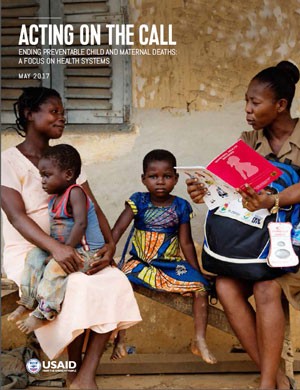- What We Do
- Agriculture and Food Security
- Democracy, Human Rights and Governance
- Economic Growth and Trade
- Education
- Ending Extreme Poverty
- Environment and Global Climate Change
- Gender Equality and Women's Empowerment
- Global Health
- Water and Sanitation
- Working in Crises and Conflict
- U.S. Global Development Lab
Since 1990, the lives of an estimated 100 million children have been saved, due in part to the efforts of USAID. Around the globe, 18,000 more children and 650 more mothers will survive today than each day in 1990.
Despite this progress, 5.9 million children under-5 still die each year, almost 1 million of them on their first day of life, and 303,000 women die annually during what should be one of the happiest days in their life.
Since 2008 alone, U.S. Agency for International Development's (USAID's) maternal and child survival efforts in 25 priority countries have saved the lives of 4.6 million children and 200,000 women.
The vast majority of these deaths are caused by complications and illnesses for which there are known, affordable treatments. Together with country partners, international organizations, and non-governmental organizations from around the globe, USAID is working to improve maternal and child survival, in support of the global movement Every Woman Every Child. USAID's Acting on the Call reports detail the U.S. Government's commitment to this goal and approach to achieving it, identifying best-practice interventions with the greatest potential for lifesaving impact when expanded. The reports formulate a roadmap for using data-driven decisions and targeted investments to save 15 million children and 600,000 women by 2020.
To reach this goal, USAID works to improve the accessibility and quality of basic interventions that can save, and have saved, millions of lives, focusing on five key areas:
- maternal health, including antenatal care, care during and around delivery, and post natal care
- newborn health
- immunization [coming soon]
- child health, including the treatment of illnesses such as diarrhea, pneumonia, and malaria
- water, sanitation, and hygiene
USAID works in 25 countries globally that together account for more than two-thirds of maternal and child deaths worldwide. These countries were selected due to the severity and magnitude of maternal and child mortality, the level of country commitment, and the potential to leverage U.S. Government programs, as well as those of other partners and donors.
Under-5 Child Mortality Rates in USAID's 25 Priority Countries for Maternal and Child Health, 2015
-
<50
-
50-74
-
75-90
-
>100
- Afghanistan
Under-5 mortality Rate: 91/1000 - Bangladesh
Under-5 mortality Rate: 38/1,000 - DRC
Under-5 mortality Rate: 98/1,000 - Ethiopia
Under-5 mortality Rate: 59/1,000 - Ghana
Under-5 mortality Rate: 62/1,000 - Haiti
Under-5 mortality Rate: 69/1,000 - India
Under-5 mortality Rate: 48/1,000 - Indonesia
Under-5 mortality Rate: 27/1,000 - Kenya
Under-5 mortality Rate: 49/1,000 - Liberia
Under-5 mortality Rate: 70/1,000 - Madagascar
Under-5 mortality Rate: 50/1,000 - Malawi
Under-5 mortality Rate: 64/1,000
- Mali
Under-5 mortality Rate: 115/1,000 - Mozambique
Under-5 mortality Rate: 79/1,000 - Myanmar
Under-5 mortality Rate: 50/1,000 - Nepal
Under-5 mortality Rate: 36/1,000 - Nigeria
Under-5 mortality Rate: 109/1,000 - Pakistan
Under-5 mortality Rate: 81/1,000 - Rwanda
Under-5 mortality Rate: 42/1,000 - Senegal
Under-5 mortality Rate: 47/1,000 - South Sudan
Under-5 mortality Rate: 93/1,000 - Tanzania
Under-5 mortality Rate: 49/1,000 - Uganda
Under-5 mortality Rate: 55/1,000 - Yemen
Under-5 mortality Rate: 42/1,000 - Zambia
Under-5 mortality Rate: 64/1,000
Under-5 Mortality Rates are taken from the A Promise Renewed Report, [PDF, 12.9MB] 2015.
* Under-5 Mortality Rates out of 1,000 live births
The U.S. Government has invested over $15 billion since 2008 in a series of innovative measures designed to accelerate reductions in mortality rates, working closely with countries and international partners in a variety of sectors. USAID works to identify and scale up those interventions proven to be effective in saving the lives of mothers and children, and invests in new technologies, procedures, and approaches to increase the efficiency and sustainability of our efforts.
We are working to ensure women and children have the same chance of survival, regardless of where they are born. Our goal is ambitious, and will require significant and sustained commitment from USAID as well as its partners. But as governments, civil society organizations, non-governmental organizations, and the private sector increasingly recognize the imperative of maternal and child health, more than ever before, our goal is achievable.
Related Resources
Acting on the Call Report
Ending Preventable Maternal Mortality: USAID Maternal Health Vision for Action
Global Health Report to Congress
More information on USAID's Maternal and Child Health program:
Countries
Multimedia
Projects
Publications
Technical Areas:
Child Health
Immunization [coming soon]
Maternal Health
Newborn Health
Water, Sanitation and Hygiene
News
STAY CONNECTED
Subscribe to the Global Health E-Newsletter and updates by entering your e-mail address below. Take a look at some of our past issues.
Follow USAID Global Health on Social Media:









Comment
Make a general inquiry or suggest an improvement.